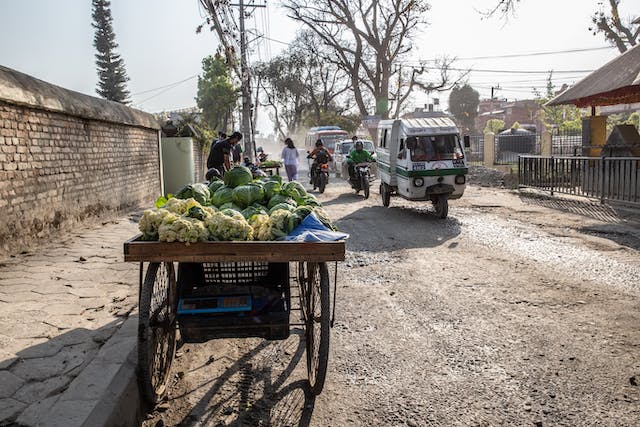A recent report from Environment Management and Policy Research Institute (EMPRI) found some alarming information about the vegetables being sold in Bangalore.
They tested 400 samples of ten different vegetables and found high levels of iron, lead, and cadmium in the vegetables.
| Vegetable type and acceptable levels | Iron 425.5 mg/kg | Cadmium 0.2 mg/kg | Lead 0.3 mg/kg | Nickel 67.9 mg/kg | Arsenic 1.0 mg/kg | Mercury 0.02 ppm |
| Brinjal | 52.30 mg/kg | |||||
| Gajar | 54.60 mg/kg | |||||
| Tomato | ||||||
| Capsicum | ||||||
| Beans | 810.20 mg/kg | 12.20 mg/kg | ||||
| Green chillies | ||||||
| Pyaaz | ||||||
| Aloo | ||||||
| Palak | 554.58 mg/kg | 53.50 mg/kg | ||||
| Coriander | 554.58 mg/kg | 53.30 mg/kg |
It’s important to remember that these numbers are not consistent across all of India, and some vegetables will be fine. This data is collected from certain areas and studies are always being conducted and advanced.
How Do Heavy Metals Get into Vegetables?
There are three ways that heavy metals can get into or onto produce:
Air: This is called atmospheric deposition and it’s when pollution particles settle on fruit and vegetables- think of the open air markets or carts by heavy traffic areas
Water: When polluted water, with factory waste or human waste, is sprayed onto crops
Soil: When the soil is polluted itself, either from dumping of waste or polluted water being used on the land. This can also be caused by excessive use of pesticides and fertiliser
In this instance from this study, they posit that the pollution has come from water. This, of course, poisons the soil too.
Why Are Heavy Metals in Food Dangerous?
Humans need a variety of minerals and vitamins, but too much or too little of something can be harmful. So while we need trace elements of arsenic, for example, too much of it can be harmful. Iron, nickel, and a number of other metals are required by human in order to survive, and this is reflected by the larger amount of ‘maximum limit for safe consumption’.
Lead, mercury, chromium, and cadmium are not required. They serve no biological function, and we do not need it in any form.
Too much of these metals can cause bone, gum, liver, nervous system, teeth, and blood diseases. This includes some cancers, pain in joints, kidney damage, problems in creating blood, reproduction defects, and problems with nervous and cardiovascular systems.
In short, they can be incredibly harmful, affect every function in your body, and should be avoided.
Can You Remove Metals From Vegetables?
The metals on the surface of the vegetables can be removed by washing thoroughly. The most effective way is with 10% acetic acid. Vinegar is 4% acetic acid, so washing and soaking in a vinegar and water solution is the best option.
Does Cooking Reduce Metals in Vegetables?
Yes. However, it’s dependent on the vegetable, the type of metal, how long you cook it for, and how it’s cooked. It’s not simply that cooked vegetables are safe. Also it depends what you cook it in; iron levels may increase further when cooked in iron vessels.
Is Organic Produce Safer with Less Metals?
In India, the Food Safety and Standards Authority of India (FSSAI) regulates use of the word ‘organic’. Primarily, in order to use the word ‘organic’, the farm must be designed in such a way that no synthetic external inputs such as chemical fertilisers, pesticides, hormones, or genetically modified organisms are used.
There are several certification systems within this. It is carried out on site and off-farm processing like transport and storage is not covered.
Inputs are strictly managed at the farming site, and there should be buffer zones maintained to avoid transfer from other sides.
However, ‘In case of reasonable suspicion of contamination, the certification programme shall make sure that an analysis of the relevant products and possible sources of pollution (soil and water) shall take place to determine the level of contamination.’
From PGS, there is acknowledgement that rainwater and runoff can contaminate soil and there is the intention to minimise that.
If processes are followed thoroughly, soil is tested for contaminants regularly, rainwater is tested to ensure no atmospheric deposition, and ‘safe’ sources of water are used, then yes, organic fruits and vegetables should be safer. It’s important to remember there are bad actors, and also things can happen that the farmers won’t know about; for instance if a factory starts disposing of waste improperly or spills effluent, it can leach into the soil. But, the FSSAI has stringent guidelines in place and do take action when required.
Are Hydroponically Grown Vegetables Safer?
If the water is clean, and the system is a closed one, then there is far less risk of heavy metal accumulation. But if the water has heavy metals, the vegetables will too. Also, fertilizers can be used in hydroponic farming, and these can add heavy metals. But on the whole, hydroponically grown vegetables are far more predictable and controllable than farming in soil.
Can the Soil and Water be Remediated from the Metals?
The advice from the majority of studies is simply to stop eating these vegetables, and while that’s great in theory, it has two major problems.
- What do those who have no choice do? Those in poverty eat what they can, when they can, and have no choice. This means they’ll suffer the burden of disease, and these are the people who can least afford healthcare or illness.
- The land must be remediated, and steps taken to minimise pollution in the first place. This is because is nothing is done, arable land will become unusable and food shortages will result. Also, the farmers still need income from their land.
Soil can be remediated in a number of ways. It’s important to note that these heavy metals do not degrade, and will persist for up to centuries. All remediation forms are expensive and potentially can take years.
–Planting some ‘hyperaccumulator’ crops such as alfalfa, canola, corn, date palms, and sunflower can help to reduce the metals. This process is called phytoextraction, phytoremediation, or bioremediation. Things like sunflower and canola can safely be used for biofuel.
-Soil flushing or washing, where fluid is pushed through the contaminated soil, removing the metals, and then the toxic water is extracted
-Chelating is when the soil is washed using acids or other agents
-Electrokinetic extraction is when charged particles are suspended in a soil solution, and precipitation at the electrodes
-Vitrification is when an electrical current is passed through electrodes inserted into the soil. The soil heats up to 2000oC and the metal is melted into blocks.
Of course, there is little to no point in remediating the soil when the water nearby is polluted.
Can the water be decontaminated? Yes, but there is no point until there’s plentiful toilets and proper waste disposal, laws that prevent dumping by factories, and penalties to corporations when it happens.

